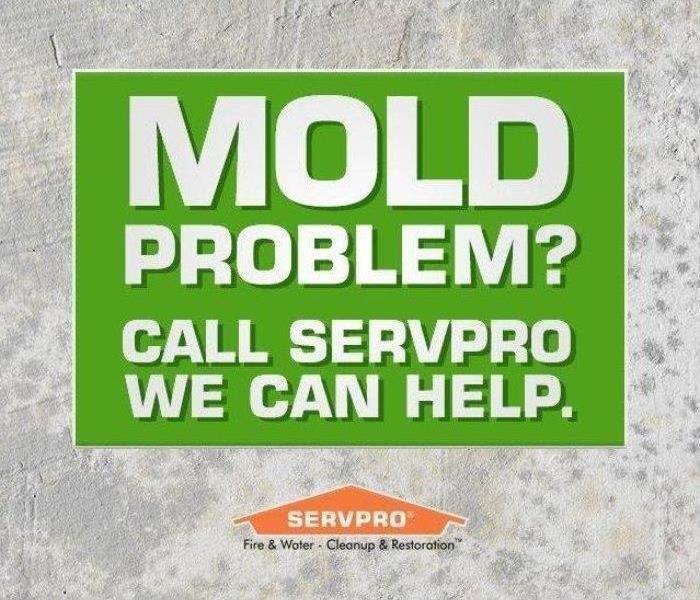Recent Mold Remediation Posts
Mold Remediation: Dangers in the Ducts
4/1/2019 (Permalink)
Mold remediation is a serious subject, covered at large by professionals and institutions that specialize on the subject matter. While I'm not a mold expert, I do know air duct cleaning and how important it is to complete an HVAC Duct Cleaning after any mold, mildew, or fire restoration. The HVAC system of a building, residential or commercial, is designed to convey the dirty undesirable air from the living space and replace it with clean, heated or cooled, conditioned air that is pleasant to breathe and comfortable to building occupants. Depending on the building type and room use, many building codes call for the air in a room to be exchanged five to 15 times per hour. For HVAC that are clean and have adequate filtration, every exchange of air generally means the indoor air quality is improving. However, when mold, mildew, soot, allergens, and other contaminants are present, in the HVAC system, the IAQ is reduced with every air exchange. Proper source removal HVAC air duct cleaning, following any restoration project, will reduce the contaminants within the HVAC system and in some cases completely remove the chances of recontamination. It sometimes is overlooked that while a building itself is being remediated, the HVAC system is still in operation and therefore moving mold spores, smoke particles, and other contaminants throughout the return and supply air duct, as well as other HVAC system components. Because the HVAC system is redistributing the air throughout the building, a small about of dirty/contaminated air has the potential to recreate the need for an entire restoration project in as little as a few days. Source removal, the practice of cleaning by removing contaminants the HVAC system, is the method prescribed within the NADCA (National Air Duct Cleaners Assocaiton) Standard, ACR-2013. Source removal can be achieved in a variety of ways, but is most often achieved by using a negative air vacuum/collector, rotating duct brushes, and compressed air whips/skippers to loosen debris from the duct walls allowing the airflow from the vacuum/collector to evacuate it from the HVAC system. The methods for a proper professional HVAC Air Duct Cleaning have been continually developed and refined for 30 years by working professionals engaged with NADCA and other IAQ associations.
Mold Remediation
11/4/2018 (Permalink)
How to determine if I can handle the mold clean up in my house?
Do I need a professional mold remediation company?
Firstly, the source of the water intrusion needs to be resolved. If the source continues to allow water intrusion, the home will eventually return to an unhealthy condition.
You might want to consult a mold remediation company….
- If the visible mold spores affected area, from tip to tip, is larger than a 10 square foot area
- If you suspect that the heating ventilation system may be contaminated
- If the original water was from a black water source (sewage contamination)
- If you have health concerns of the occupants
There are numerous mold cleaning products on the market for consumer use. It is best not to use OVER USE any harsh chemicals. Simply scrub hard surfaces with a detergent and water, and let the area dry. It is very important to use personal protective equipment while cleaning: eyes, hands, and respiratory system. Upon completion of the cleaning, the area should be free of visible mold spores and musty, moldy odors (mold staining on structural materials may still be present). It is critical to monitor the affected area for a few months to make sure the area does not return to unhealthy. The area needs to continue to be dry, clean and odor free. If the area again begins to deteriorate, go back to correction of the source of water intrusion. It is possible that the original correction was not sufficient or there might a secondary source of water intrusion.
If you determine that your home or business has a mold problem, and the source of the moisture intrusion has been corrected, SERVPRO of Northern Summit County can inspect and assess your property. If professional mold remediation is needed, we have the training, equipment, and expertise to handle the situation.
Vacant Homes and Mold Growth
11/3/2018 (Permalink)
Vacant homes or unattended homes have unique issues that can that increase the likelihood of mold growth. These homes are locked up without inhabitants coming or going, turning on the heat, running air exchangers or ventilation fans, and have restricted air flow. Thus moisture or condensation can build up inside and create an ideal climate for mold. To thrive mold needs moisture, oxygen, a food source and a surface on which to grow; easily available within a residence. Mold spores are abundant in our environment, and once a mold spore has attached itself to dust particles, which provides the nutrients needed, all the spore needs is moisture.
Procrastinate where mold cleaning is necessary can be a costly decision. If mold spores are allowed to proliferate, you may be faced with extensive structural damage to your home and possibly loss of property value. Today’s buyers are very leery about investing into a home with visible mold contamination. Additionally, consumers are very aware that some molds species can produce toxins and allergens.
The remediation priority would be to correct the excessive of moisture build up in the residence. Remediation would include 1) water proofing, 2) corrective measures to secure windows and doors, 3) create healthy air flow. etc. After the corrective measures to reduce the moisture, professional mold remediation of all affected structural materials, contents, and HVAC system would need to be completed. If the issues that are causing the elevated moisture are not corrected prior to remediation services, after a period of time, the home would again become unhealthy.
If you determine that your home or business has a mold problem, and the source of the moisture intrusion has been corrected, SERVPRO of Northern Summit County can inspect and assess your property. If mold remediation is needed, we have the training, equipment, and expertise to handle the situation.
Evaluating Mold: Air Sample Testing
11/3/2018 (Permalink)
All buildings contain mold spores since they a natural part of the environment. An elevated mold count especially one that contains spores from varieties of mold that are commonly found when water damage is involved, such as stachybotrys chartarum, can indicate that there may be a structural moisture problem.
In the insurance claim process, mold testing in is generally utilized after the mold has been remediated to confirm that the mold spore count is at or below the count found outside the building. The test is conducted while the remediated area is contained in order to confirm the success of the cleaning process.
Determination of airborne spore counts is accomplished by way of an air sample, in which a specialized pump with a known flow rate is operated for a known period of time. Conducive to scientific methodology, air samples should be drawn from the affected area, a control area, and the exterior.
The air sampler pump draws in air and deposits microscopic airborne particles on a culture medium. The medium is cultured in a laboratory and the fungal genus and species are determined by visual microscopic observation. Laboratory results also quantify fungal growth by way of a spore count for comparison among samples. The pump operation time was recorded and when multiplied by the operation time results in a specific volume of air obtained. Although a small volume of air is actually analyzed, common laboratory reporting techniques extrapolate the spore count data to equate the amount of spores that would be present in a cubic meter of air.
If you have questions or need further information about the mold testing process, contact SERVPRO of Northern Summit County at 800-648-1212.
Health Hazards Lurking in Your Basement
10/21/2018 (Permalink)
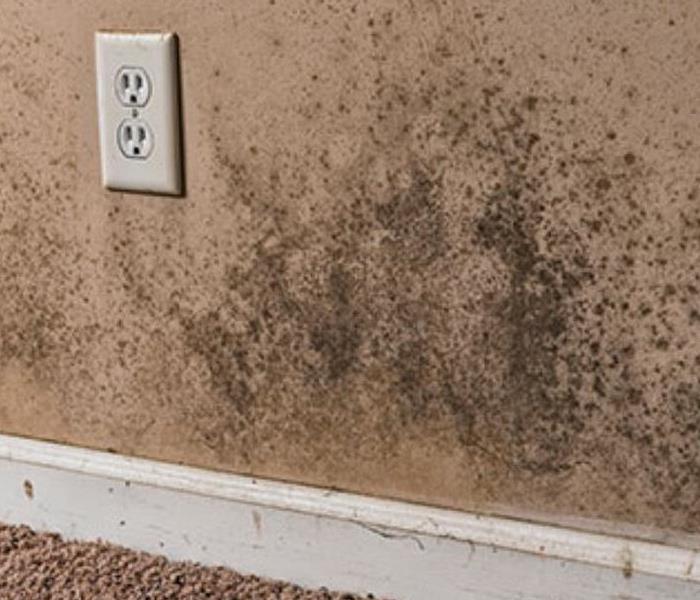 Basement mold can happen to anyone.
Basement mold can happen to anyone.
Basements are damp, which is precisely the environment in which mold thrives. To reduce the risk of mold, use a dehumidifier, seal cracks in the foundation, and replace carpeting with tile, vinyl, or another appropriate hard flooring.
Not every basement laundry area enjoys adequate dryer venting from the basement to the outdoors. You laundry area could even be on the main floor or the upstairs of the home.Rather than running a vent pipe to the outside of the house, some homeowners opt to outfit the dryer with a device that catches lint and then recirculates warm air from the dryer throughout the basement. Unfortunately, the exhaust from the dryer also includes chemicals from laundry detergents. If you spend any time in your basement, have your dryer vented to the outdoors.
Homeowner’s and Renter’s Guide to Mold Cleanup After Disasters
10/3/2018 (Permalink)
Cleaning up after a flood can pose health risks. You and your family should wait to re-enter your home until professionals tell you it is safe, with no structural, electrical or other hazards.
Before you start cleanup activities, contact your insurance company and take pictures of the home and your belongings. Remember – drying your home and removing water-damaged items is your most important step for preventing mold damage.
Is There a Problem?
Was your home flooded? If so, and you were not able to dry your home (including furniture and other items) within 24-48 hours, you should assume you have mold growth. You need to completely dry everything, clean up the mold, and make sure you don’t still have a moisture problem.
You may see or smell mold on clothing, drywall, furniture, cardboard boxes, or books, but it may also be hidden under or behind items like carpet, cushions, or walls.
Mold Basics: How Molds Can Affect Your Health
Key Messages
- Wear personal protective equipment. Wear an N-95 respirator at a minimum, goggles, and protective gloves.
- Use portable generators carefully, outside and away from the home, to avoid carbon monoxide poisoning and fires.
- Ensure the mold cleanup is complete before reoccupying your home.
Exposure to mold can lead to asthma attacks, eye and skin irritation, and allergic reactions. It can lead to severe infections in people with weakened immune systems. Avoid contaminated buildings and contaminated water as much as you can.
Flood water may have carried sewage or chemicals into your home. This could expose you or your family to viruses, bacteria, disease carriers (such as mosquitoes), and parasites, as well as mold. To learn more about cleaning and disinfection go to: www.cdc.gov/healthywater/emergency/flood/standing.html.
You can protect yourself and your family from mold exposure by following these steps.
Before You Enter Any Moldy Site:
- Protect yourself and loved ones against hazards. People with breathing problems like asthma or who have weakened immune systems should stay away from moldy sites. Children should not take part in disaster cleanup work. Check for loose power lines or gas leaks. Make sure the electricity and gas are turned off. Look for sagging ceilings or floors or other structural problems. Watch out for wet, muddy, or slippery floors.
- Protect your mouth and nose against breathing in mold: wear at least an N-95 respirator. If you plan to spend a lot of time removing moldy belongings or doing work like ripping out moldy drywall, wear a half-face or full-face respirator. Basic information on using it is in OSHA’s general respiratory protection guidance.
- Protect your skin. Wear protective gloves (non-latex, vinyl, nitrile, or rubber). Do not touch mold or moldy items with bare hands.
- Protect your eyes. Wear goggles that provide complete eye protection. Choose goggles designed to keep out dust and small particles. Safety glasses or goggles that have open vent holes will not protect you against dust and small particles.
After You Leave a Mold Site:
- Protect yourself and loved ones. Shower and change your clothes. This will help you avoid carrying mold and other hazards back to your current living quarters.
Should I Do This Myself?
This job may be too difficult or dangerous for you. It may be best to get help from experienced and qualified professionals if you can. Hire a mold inspection or remediation professional affiliated with or certified by the National Environmental Health Association (NEHA), the American Industrial Hygiene Association (AIHA), the Institute of Inspection, Cleaning and Restoration Certification (IICRC), or American Council for Accredited Certification (ACAC) to inspect, repair, and restore the damaged parts of your home. Your state also may regulate mold remediation.
Sampling for mold is not usually recommended. Understanding the results can be difficult, and no matter what kind of mold is in your home, you need to clean it up and fix the moisture problem.
If I Must Do This Myself, How Can I Do It Safely?
Follow these steps:
- Put on the personal protective equipment described above to protect your eyes, nose, mouth, and skin.
- Remove standing water and wet materials. Use a wet vacuum to remove water from floors, carpets, and hard surfaces. Dry your home and everything in it as quickly as you can – within 24 to 48 hours if you can.
- Open all doors and windows when you are working and leave as many open as is safe when you leave.
- Open inside doors, especially closets and interior rooms, to let air flow to all areas. Take doors off their hinges if you need to.
- Open kitchen cabinets and bathroom vanity doors; remove drawers, wipe them clean, and stack them to dry.
- Open the attic access to let air flow to the attic. Before you open the attic door, make sure nothing will fall on you.
- When electricity is safe to use, use fans and dehumidifiers to remove moisture. Do not use fans if mold has already started to grow, because the fans may spread the mold.
- Clean with water and a detergent. Remove all mold you can see. Dry right away.
- If you use cleaning products, do not mix cleaning products together. DO NOT mix bleach and ammonia because it can create toxic vapors.
- Painting or caulking over mold will not prevent mold from growing. Fix the water problem completely and clean up all the mold before you paint or caulk.
- Throw away items that can’t be cleaned and dried. Throw away anything that was wet with flood water and can’t be cleaned and dried completely within 24 to 48 hours. If you have precious items that you want to preserve, follow these guidelines from the Smithsonian Institute: www.si.edu/mci/english/learn_more/taking_care/mnm.html.
Safety Tips on Using Portable Generators
- If you use a portable generator for electricity use CAUTION to avoid carbon monoxide poisoning and fires.
- Use portable generators OUTSIDE and at least 20 feet away from buildings.
- Do not use portable generators inside your house or garage.
- Do not put portable generators on balconies or near doors, vents, or windows.
- Do not use portable generators near where you or your children are sleeping.
- Never refuel a generator while it is hot.
- For more information, go to: www.osha.gov/OshDoc/data_Hurricane_Facts/portable_generator_safety.pdf[PDF – 22 KB]
Am I Done?
- If you still see or smell mold, you have more work to do. After a remediation, there should be no signs of water damage or mold growth.
- You may need to ask a mold remediation professional to know whether your mold problem is completely fixed. As noted in the “Should I do this myself?” section, sampling for mold is not usually recommended; instead, a careful inspection of the work area for completion of the cleanup and absence of mold-related odors is usually appropriate.
- If you have health problems that get worse when you return home, like asthma or allergy attacks or skin or eye irritation, you may still have some mold.
Insurance questions grow alongside mold, fungi and algae
8/15/2018 (Permalink)
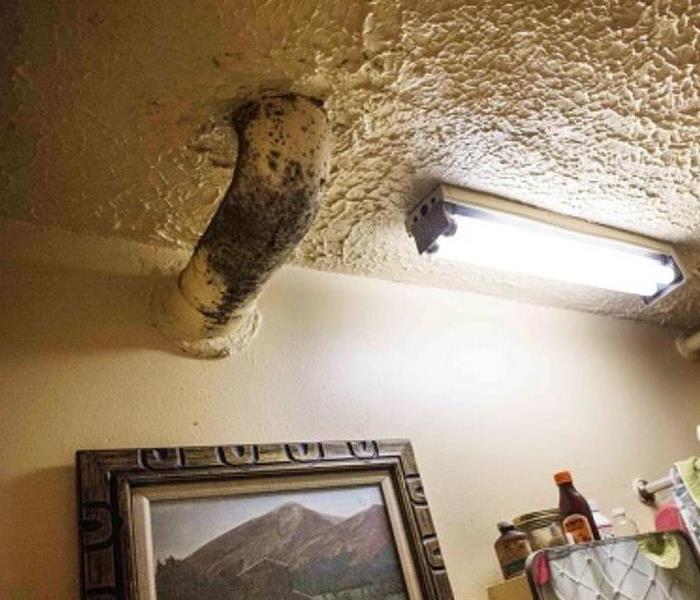 Black mold growing inside a home.
Black mold growing inside a home.
Analysis brought to you by the experts at FC&S Online, the recognized authority on insurance coverage interpretation and analysis for the P&C industry. To find out more — or to have YOUR coverage question answered — visit the National Underwriter website, or contact the editors via Twitter: @FCSbulletins.
Question: I know of the exclusions for mold, rot, deterioration, etc. However, I do not think that is what this is. I was just reading this article about algae, lichen and moss, and it talks about how algae, lichen or moss “eat” the limestone from shingles. This is not deterioration, per se. Looking at a standard homeowners’ policy, I could not locate an exclusion. Also, it states in the policy they pay for risk of direct physical loss; no mention of the words, “Sudden” or “Accidental.”
Should this claim be covered?
— Hawaii Subscriber
Answer: Good question. Algae and fungi are different organisms, as far as I can tell. So the exclusion for mold, fungus and dry rot does not apply.
All living things are broken down into kingdom, phylum, class, order, family, genus species. Since Algae and fungus are in two different kingdoms, they are different. For example, a house cat is the kingdom animalia, phylum chordata, class mammalia, order carnivora, family felidae, genus felis, species catus.
People are kingdom animalia, phylum chordata, class mammalia, order primates. Notice that people and cats share the same kingdom, phylum and class. Since algae and fungus start out with different kingdoms, they’re different.
However, by the time the roof is covered with dark streaks or moss or lichen, you have a maintenance issue, which is excluded. An insured is responsible for taking care of the covered property; if that involves having the roof pressure washed now and again, it’s his responsibility. Same with the siding; it needs to be power washed or cleaned in some areas on a regular basis. The exclusion isn’t for the plant life, it’s for letting it get so bad that it damaged the roof.
Is algae considered a contaminant?
Question: We have a claim with a company that provides swimming pool maintenance as well as lifeguards. The claimant alleges that she slipped and fell on algae that formed around a drain due to stagnant water being formed.
My question is: Would algae be considered a microorganism or organic contaminant? And if so, would it be excluded, even though the claimant was not injured by it but slipped on it?
— Kentucky Subscriber
Answer: The claimant slipped on the algae and was injured so you cannot really say she was not injured by the algae but only slipped on it. If the claimant slipped on water or tripped over a chair and was injured, the insured could still be held to have acted negligently even though the water or chair did not injure the claimant, so it is the same with slipping on algae.
As for algae, the opinion here is that algae is an organic contaminant in this instance, especially since the exclusion in question states the following: “including but not limited to mold, mildew, fungus, spores.” Algae is a plantlike organism, a biological (living) organism, so the exclusion would apply.
Deciphering the microorganism exclusion
Question: The insured is a hotel. Claimant and her children and husband stayed at the insured hotel for seven days. A week after the claimant left the hotel, she went to the doctor and alleged she sustained bed bug bites. We have received reports from the claimant’s doctors stating that she had scabies. In review of the microorganism exclusion (AD68830413), it excludes biological organisms. In review of the definitions of “scabies” (Sarcoptes scabiei), it does not appear to fall into this category. We have reserved our rights at the present time but would like your opinion as to whether or not you agree that scabies would not be considered a microorganism.
— New Jersey Subscriber
Answer: The policy does not define the term “microorganism,” so we turn to the dictionary. ‘Scabies’ is defined as, “an infestation of the scabies mite (Sarcoptes scabiei).”
‘Microorganism’ is defined as, “any organism too small to be viewed by the unaided eye, as bacteria, protozoa, and some fungi and algae.”
‘Organism’ is defined as, “a form of life considered as an entity; an animal, plant, fungus, protistan, or moneran.”
This description of scabies from MedicineNet.com leaves no doubt that scabies are a form of life too small to be viewed by the human eye:
Scabies is an itchy, highly contagious skin disease caused by an infestation by the itch mite Sarcoptes scabiei. Mites are small eight-legged parasites (in contrast to insects, which have six legs). They are tiny, just 1/3 millimeter long, and burrow into the skin to produce intense itching, which tends to be worse at night. The mites that infest humans are female and are 0.3 mm-0.4 mm long; the males are about half this size. Scabies mites can be seen with a magnifying glass or microscope. The scabies mites crawl but are unable to fly or jump. They are immobile at temperatures below 20 C, although they may survive for prolonged periods at these temperatures.
Ambiguities in the policy must be read in favor of the insured, and exclusions must be narrowly read. However, the common meaning of the terms “microorganism” and “organism” leave no room for ambiguity. Scabies mites are alive and microscopic. Thus, scabies can be considered microorganisms. It is our interpretation of the facts that scabies are excluded here by the microorganism exclusion.
Artillery fungus damage
Question: Our homeowner recently had mulch delivered to his home by a local nursery. After the mulch was spread around his plants, some artillery fungus sprung from it and attached themselves to the home. The paint job is now ruined and substantial expense will be involved to remove the fungus and re-paint the home.
The insurer has denied the claim based on the exclusion of the, “release, discharge, or dispersal of pollutants or contaminants.” This interpretation seems rather harsh to us and we would appreciate your thoughts on the matter.
— Pennsylvania Subscriber
Answer: The current ISO homeowners form 3 excludes damage done by the “release, discharge, or dispersal of pollutants or contaminants.” Webster’s Ninth New Collegiate Dictionary says that a contaminant is something that contaminates — it soils, stains, corrupts, or infects by contact or association. This is what the artillery fungus has done and such damage would be properly excluded by an ISO homeowners.
However, as we have said on other occasions, we do not believe that this is the type of claim intended to be reached by the exclusion. It is a sudden and accidental claim and out of the control of the insured. The insurer must examine its own claims-paying philosophy regarding payment of the claim. But, as we said, it is technically not covered.
On the other hand, one independently filed homeowners form does not contain such wording. Rather, it excludes contamination — a process that occurs over time. That is what we believe to be the spirit of the exclusion — to avoid coverage for the long-term contamination and pollution exposure.
If the homeowners carrier does pay the claim, then it has a cause of action against the nursery that provided the mulch. However, if the homeowners insurer denies the claim, then the insured homeowner must institute his own action against the nursery.
When mold remediation is part of the job
Question: Our insured is a pest control business. Endorsement CG 24 25, limited fungi or bacteria coverage, is attached to the insured’s CGL form and the question we have is this: Does this endorsement cover the insured’s exposure for the mold work he performs?
The insured will tear out and treat mold ridden areas of a home or business. Does CG 24 25 provide coverage for the insured for the work he does to contain, treat, and neutralize mold? If the insured completes his work and then the mold comes back in a month or so, will he have coverage for a claim made against him?
— Pennsylvania Subscriber
Answer: CG 24 25 will provide liability coverage for the insured is a claim is made against him for bodily injury or property damage based on the inhalation or ingestion or contact with or exposure to mold (that is, fungi) or bacteria within a building or structure. So, if the insured treats a house and then down the road, the insured is sued because the mold comes back and causes a health issue, the endorsement will provide coverage.
Now, there is no coverage for re-doing the insured’s work, that is, correcting the previous work. The endorsement only applies to claims for BI or PD and does not apply to any expense or costs to do any re-mediating or correcting any previous negligent work on the part of the insured.
Mold coverage and a rot endorsement
Question: An insured has a very large two-story deck off the front of his home. He lives on the Oregon Coast, so the wood has a tendency to rot and decay faster than in other regions. The underside of the deck is open, which is clearly visible from the ground floor. It was found that one of the 6×6 wooden support posts along with other parts of the deck has started to rot and needs to be replaced. The insured believes coverage should be extended under the wet or dry rot endorsement. Your thoughts?
— Minnesota Subscriber
Answer: The policy ( HO 00 03 02 00 with HO 04 05 12 02) has the usual wear and tear exclusion, as well as the mold, wet or dry rot exclusion. The endorsement provides coverage for fungi, wet or dry rot when the loss is caused by a peril insured against. The insured’s damage to the deck is simply wear and tear and is not covered, even by the endorsement.
The endorsement excludes the presence of condensation, humidity, moisture or vapor over a number of weeks unless the damage is unknown to the insured and hidden. As the deck is readily visible, and the insured knows he’s in an area that is prone to faster decay due to being on the coast, the damage to the deck was not hidden.
Overlooking Water Leaks in Your Home- A Mold Threat
3/6/2018 (Permalink)
DO NOT overlook water leaks in your home. Beware of mold.
A Chubb survey revealed the majority of homeowners do not view internal water leak damage as the most concerning home threat.
Chubb North America Personal Risk Services Division President, Fran O'Brien, said "the time between when a leak occurs and when it's discovered is the single greatest factor in determining the amount of damage."
Nearly 80 percent of homeowners overlook the threat of costly water leaks while on vacation, Chubb survey found. Something to consider as families leave for Spring vacation.
And on top of the drip, drip, drip of what could start as a minor leak, depending on the duration of your Spring vacation, the drip, drip, drip could result in not only water damage to your home, but mold damage as well. For information on how that works, refer to our blog post, 5 Levels of Mold Remediation.
If you'd like to know more about Chubb's survey, click here to visit their site.
Mold Damage ? Water Damage ? Call SERVPRO of Northern Summit Conuty's 24/7 Emergency Service Line at 330-650-4486, or Request Help Online.
How to Remove Mold And Mildew Stains From Washable Clothes
11/23/2017 (Permalink)
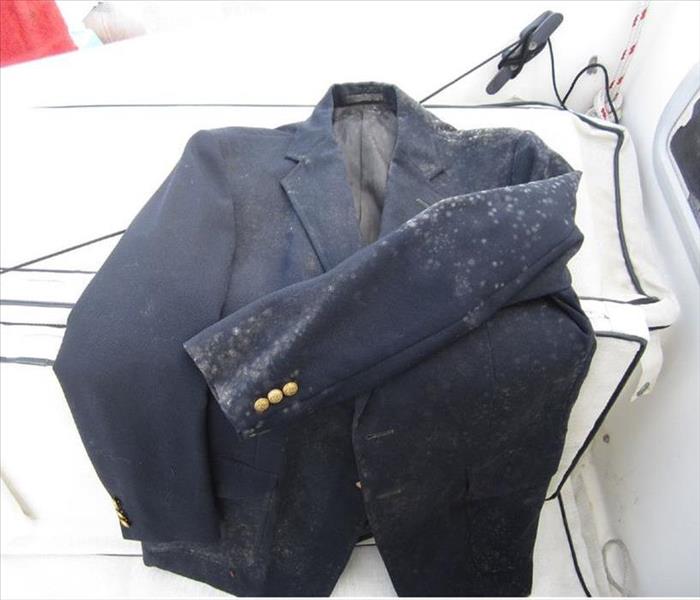 Even if you can't see any spots or growth, if the odor is present there are spores growing and treatment is necessary.
Even if you can't see any spots or growth, if the odor is present there are spores growing and treatment is necessary.
Mold can easily grow on clothes and fabric if you have too much moisture in your home. Clothes made of cotton or other organic materials make great food sources for mold and mildew to live on.
There are a few tips to keep in mind when removing mold from clothes:
- It's best to wash your clothes in hot water. Hot water kills mold more effectively than cold water and better removes mold spores and allergens too. Of course make sure you don't use water so hot that it can damage your clothing.
- When you're washing your clothes with a mold killing solution, it's best to wash them through at least two full cycles. Then after your clothes have been washed hang them on the line in the sun. The heat from the sun and the sun's ultraviolet light help to kill mold.
There are quite a few solutions you can wash moldy clothes in to get rid of the mold. Some good ones include:
- Bleach
- Borax
- Vinegar
- Baking soda
- Mold killing detergent
For the full article and a step-by-step explanation of the cleaning process, click here.
Does your home or business have mold damage? Call SERVPRO of Northern Summit County at 800-648-1212
A Brief Guide to Mold, Moisture and Your Home
11/17/2017 (Permalink)
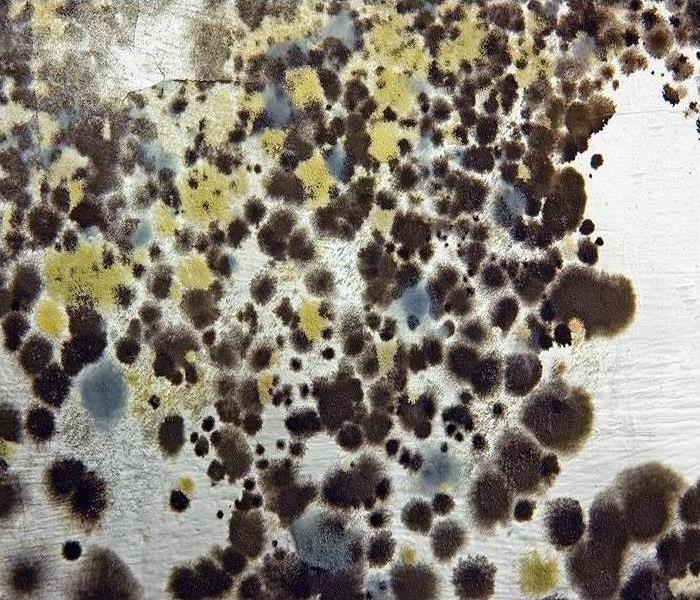 SERVPRO of N. Summit County can respond quickly, working to first contain the mold infestation and prevent its spread to other parts of the building.
SERVPRO of N. Summit County can respond quickly, working to first contain the mold infestation and prevent its spread to other parts of the building.
Provided by the U.S. Environmental Protection Agency, Office of Air and Radiation- Indoor Environments Division, this Guide provides information and guidance for homeowners and renters on how to clean up residential mold problems and how to prevent mold growth.
Contents:
- Mold Basics
- Why is mold growing in my home?
- Can mold cause health problems?
- How do I get rid of mold?
- Mold Cleanup
- Who should do the cleanup?
- Mold Cleanup Guidelines
- What to Wear When Cleaning Moldy Areas
- How Do I Know When the Remediation or Cleanup is Finished?
- Moisture and Mold Prevention and
Control Tips- Actions that will help to reduce humidity
- Actions that will help prevent condensation
- Testing or sampling for mold
- Hidden Mold
- Cleanup and Biocides
- Additional Resources
Click Here for the full PDF file
Have a Mold Problem? Call SERVPRO of Northern Summit County Today – 800-648-1212
Is It Possible to Restore Clothes that Have Been Affected by Mold?
11/9/2017 (Permalink)
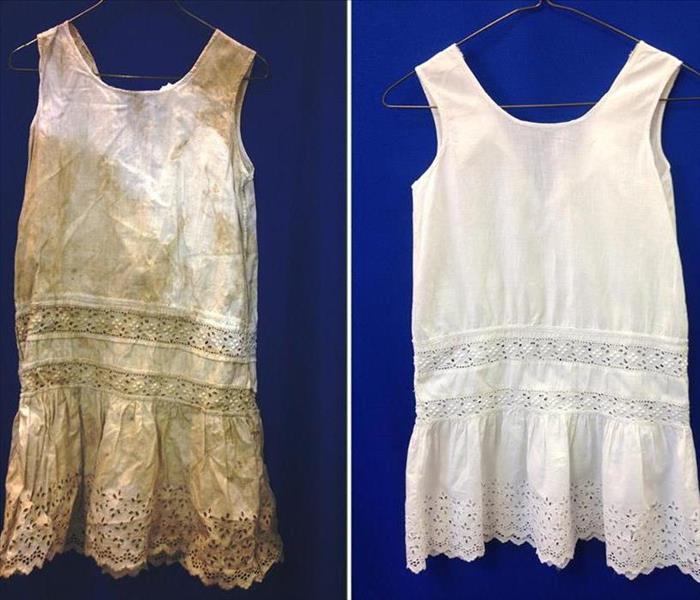 If you decide to remove mold from clothes yourself, be sure you do it safely. Refer back to our blog for more on clothing restoration.
If you decide to remove mold from clothes yourself, be sure you do it safely. Refer back to our blog for more on clothing restoration.
Any garment or fabric that has not suffered physical deterioration or discoloration as a result of mold growing on it, and that is washable (typically, a minimum of 130ºF for at least 10 minutes), can be restored completely. That goes for bacterial contamination as well, as evidenced by hospitals daily as they wash linens, gowns, surgical drapes, etc.
Dry cleaning also does a good job when evaluated and cleaned - often twice - by a qualified professional. Again, this assumes no deterioration or discoloration of the garment. Ultimately, sampling and evaluation by a qualified environmental professional can be used to confirm remediation of the garment.
Professional restoration technicians understand the need for quick response. Immediate remediation is key to controlling any escalating costs. The longer the remediation is delayed, the higher the cost of restoration. Certified restorers have the knowledge to test materials and apply the restoration techniques required to return the items to their preloss condition. Look for the IICRC logo to verify IICRC certification.
Does your home or business have mold damage? Call SERVPRO of Northern Summit County at 800-648-1212
Mold Cleanup Information for You and Your Family
10/23/2017 (Permalink)
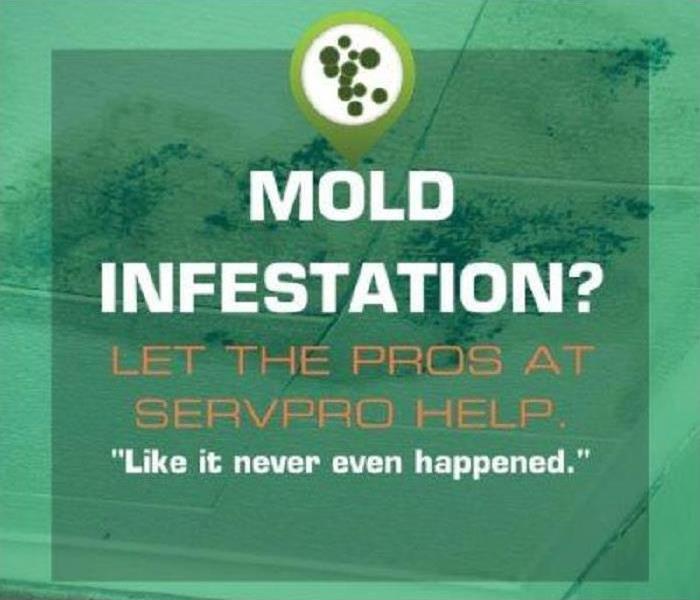 We invest in the latest equipment and ongoing mold remediation training because it helps us restore your home or business quickly and effectively.
We invest in the latest equipment and ongoing mold remediation training because it helps us restore your home or business quickly and effectively.
Molds are a natural part of the environment. They can be found anywhere there is water and moisture, so the key to controlling them in and around your home or business is moisture control. If mold is found in your home or business, you should clean up the mold promptly and fix the water problem immediately. It is also important to dry water-damaged areas and items within 24-48 hours to prevent mold growth.
Centers for Disease Control and Prevention offer resources for proper and safe mold cleanup. Click here for more information on mold cleanup information for you and your family.
Mold Damage? SERVPRO of Northern Summit County will help- 330-650-4486
Also check out our webpage for our mold remediation process.
5 Levels of Mold Remediation
8/28/2017 (Permalink)
When dealing with mold contamination in your home it can be difficult to decide when a mold remediator is needed or what you can take care of yourself.
In the following 5 levels, you will have a guideline to go by when removing mold from your home:
- Level I (10 square feet or less)Mostly found on ceilings or baseboards. Level I mold contamination may be cleaned without hiring a mold remediator, but there are several important safety precautions that you need to know:
Do not attempt cleaning mold if you suffer from asthma, allergies, or immune disorders
Wear gloves, eye protection, and an N95 disposable respirator
Vacate from your work area any infants less than 12 months old, individuals recovering from recent surgery, anyone with a suppressed immune system, or people with chronic lung diseases such as asthma, sever allergies, emphysema, etc.
Contaminated materials that cannot be cleaned should be removed from your home in a sealed plastic bag to prevent an infestation in another part of your home
Clean your work area when you’re done with a damp cloth or mop
Make sure all areas are left dry and visibly free of mold contamination
- Level II (10-30 square feet)About the size of one wall panel. To clean, the same precautions used in Level I should be taken.
- Level III (30-100 square feet)
The size of patches of mold on several wall panels. To clean, the same precautions used in Level I and II should be taken, as well as:- Seal ventilation ducts/grills in the work area and areas directly adjacent with plastic sheeting
- Vacate everyone from your work area until work is completed.
- Level IV (greater than 100 square feet)
An infestation depending on how much greater than 100 square feet may require the assistance of a mold remediator. If not, the same requirements should be followed as were needed in levels I, II, and III along with the following:- Every worker must be trained in the handling of hazardous materials and equipped with full face respirators with high-efficiency particulate air (HEPA) cartridges, with disposable protective clothing covering both head and shoes.
- Make sure workers completely isolate their work area from the rest of your home with sheeting sealed with duct tape, including ventilation ducts/grills, fixtures, and any other openings.
- Air monitoring should be conducted prior to moving back into your home to determine if it is fit to reoccupy.
- Level V (Air Conditioners and HVAC Systems)
All remediation procedures for air conditioning units and HVAC systems should be left to professionals. Procedures for level V remediation for areas larger than 10 square feet are the same for all previous levels with the following precautionary measures added:- Shut down the HVAC system prior to remediation
- Growth-supporting materials that are contaminated, such as the paper on the insulation of interior lined ducts and filters, should be removed and sealed in plastic bags
- A variety of biocides – broad spectrum antimicrobial agents designed to prevent the growth of microorganisms – are recommended by HVAC manufacturers for use with HVAC components, such as cooling coils and condensation pans. HVAC manufacturers should be consulted for the products they recommend for use in their systems.
Do you have mold in your home or business? With questions or if you need a mold remediator, call our 24/7 Emergency Service line at (330) 650-4486. Request help online by clicking here.
Do You Need a Mold Remediator?
8/9/2017 (Permalink)
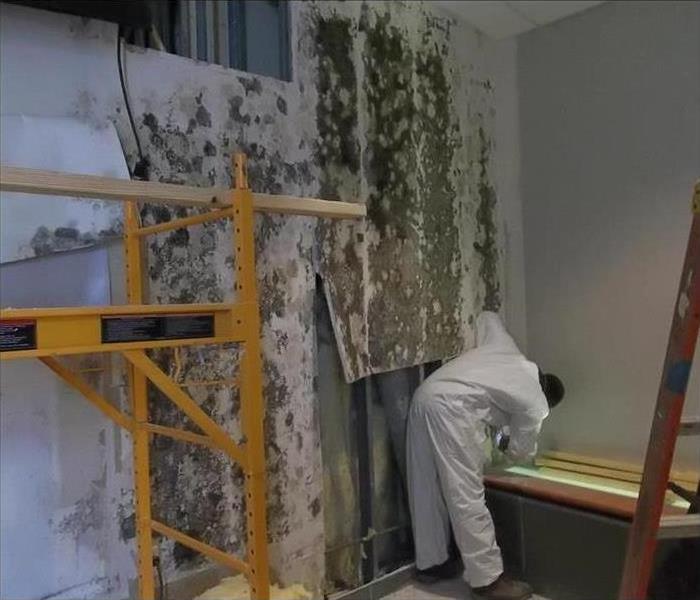 Mold spores thrive on moisture. They can quickly grow into colonies when exposed to water and produce allergens and irritants.
Mold spores thrive on moisture. They can quickly grow into colonies when exposed to water and produce allergens and irritants.
If you suspect mold in your home or business, you're probably anxious to get the problem taken care of as soon as possible. If you have small children, older adults or animals, it is even more important to effectively rid your home of mold so it doesn't affect their health.
When choosing a reliable mold remediator, it is important to consider the following tips:
- Only choose mold remediators that are certified. To ensure the highest quality of service, go with mold remediators that perform all of their own inspections and remediations. Generally, those who have been in business for a while and who have worked in a variety of settings including commercial and residential areas will be able to perform the most reliable services.
- Find a mold remediator that will inspect your home before they begin work. Later, the mold remediators should perform both an air-quality check and a swab check to test for mold. SERVPRO, among other mold remediation companies, will test for asbestos and lead as well as different types of mold. Make sure that contact information is included in the proposal so you’ll know who to get in touch with in case of problems.
- Check for a warranty. It is an assurance by one party to the other party that specific facts or conditions are true and/or will happen. Check that the mold remediator also offers to come back and redo any area that shows signs of mold within six months to a year.
It is important to take some extra time to choose the best mold remediator to avoid further serious problems in your home or business.
If you are experiencing troubles with mold, call us at our 24/7 Emergency Service number, 800-648-1212 or request help online.
Follow These Mold Safety Tips If You Suspect Mold
5/25/2017 (Permalink)
If you see visible mold, do not disturb it. You can inadvertently spread the mold infestation throughout your home or business. When mold is disturbed, the mold can release microscopic mold spores which become airborne and can circulate inside your building.
What to Do:
- Stay out of affected areas.
- Turn off the HVAC system and fans.
- Contact SERVPRO of Northern Summit County, Portage County and Canton for mold remediation services.
What Not to Do:
- Don’t touch or disturb the mold.
- Don’t blow air across any surfaces with visible or suspected mold growth.
- Don’t attempt to dry the area yourself.
- Don’t spray bleach or other disinfectants on the mold.
About Our Mold Remediation Services
SERVPRO of Northern Summit County, Portage County and Canton specialize in mold cleanup and restoration, in fact, it’s a cornerstone of our business. Our crews are highly trained restoration professionals that use specialized equipment and techniques to properly remediate your mold problem quickly and safely.
If You See Signs of Mold, Call Us Today – 800-648-1212
Does Your Home or Business Have A Mold Problem?
5/11/2017 (Permalink)
 Building with structural mold damage.
Building with structural mold damage.
Microscopic mold spores naturally occur almost everywhere, both outdoors and indoors. This makes it impossible to remove all mold from a home or business. Therefore, mold remediation reduces the mold spore count back to its natural or baseline level. Some restoration businesses advertise “mold removal” and even guarantee to remove all mold, which is a fallacy. Consider the following mold facts:
- Mold is present almost everywhere, indoors and outdoors.
- Mold spores are microscopic and float along in the air and may enter your home through windows, doors, or AC/heating systems or even hitch a ride indoors on your clothing or a pet.
- Mold spores thrive on moisture. Mold spores can quickly grow into colonies when exposed to water. These colonies may produce allergens and irritants.
- Before mold remediation can begin, any sources of water or moisture must be addressed. Otherwise, the mold may return.
- Mold often produces a strong, musty odor and can lead you to possible mold problem areas.
- Even higher-than-normal indoor humidity can support mold growth. Keep indoor humidity below 45 percent.
If your home or business has a mold problem, we can inspect and assess your property and use our specialized training, equipment, and expertise to remediate your mold infestation.
Stay tuned for our next blog featuring mold do's and don't's!






 24/7 Emergency Service
24/7 Emergency Service


